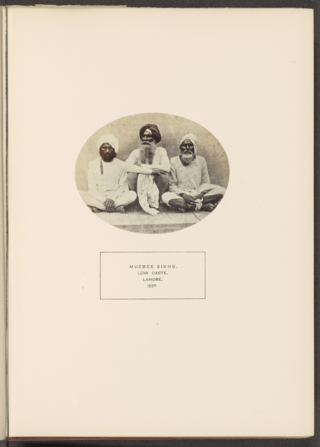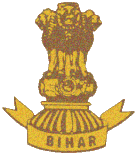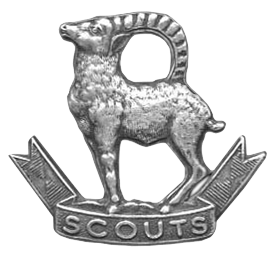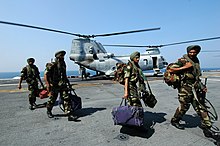
The Jammu and Kashmir Rifles is an infantry regiment of the Indian Army. Its origins lay in the Jammu and Kashmir State Forces of the princely state of Jammu and Kashmir. After the accession of the state to the Indian Union in October 1947, the State Forces came under the command of the Indian Army. They remained in the original form until 1956 when Jammu and Kashmir Constituent Assembly effectively ratified the state's accession to India. Then the State Forces became the Jammu and Kashmir Regiment of the Indian Army. In 1963, the designation was changed to Jammu and Kashmir Rifles. After the conversion, the Ladakh Scouts came under the aegis of the Regiment, where it remained until raised as a separate Regiment in 2002.

The Brigade of The Guards is a mechanised infantry regiment of the Indian Army. It was raised as the first "all India", "all class" infantry unit of the Army where troops from all parts of India serve together, as opposed to other regiments that recruit from specific regions, ethnic groups or religions.

The Parachute Regiment is an airborne and special forces regiment of the Indian Army. It was raised in 1945 as part of the British Indian Army but was disbanded after World War II and was re-raised in 1952 as part of the Indian Army. Currently it consists of fifteen Special Forces, two Territorial Army and one Rashtriya Rifles battalions.

The Sikh Regiment is an infantry regiment of the Indian Army. Sikh regiment is the highest decorated regiment of the Indian Army and in 1979, the 1st battalion was the Commonwealth's most decorated battalion with 245 pre-independence and 82 post-independence gallantry awards, when it was transformed into the 4th battalion, Mechanised Infantry Regiment. The first battalion of the regiment was officially raised just before the partial annexation of the Sikh Empire on 1 August 1846, by the British East India Company. Currently, the Sikh Regimental Centre is located in Ramgarh Cantonment, Jharkhand. The Centre was earlier located in Meerut, Uttar Pradesh.

The Kumaon Regiment is one of the oldest infantry regiments of the Indian Army. The regiment traces its origins to the 18th century and has fought in every major campaign of the British Indian Army and the Indian Army, including the two world wars, and is one of the highest decorated regiments of the Indian Army.

The Punjab Regiment is the second oldest regiment still in service in the Indian Army, and is the most senior regional infantry regiment. It was formed from the 2nd Punjab Regiment of the British Indian Army in 1947 and has taken part in various battles and wars since, winning numerous honours for the same.

The Nihang or Akali, also known as Dal Khalsa, is an armed Sikh warrior order originating in the Indian subcontinent. Nihangs are believed to have originated either from Fateh Singh and the attire he wore or from the "Akal Sena" started by Guru Hargobind. Early Sikh military history was dominated by the Nihang, known for their victories where they were heavily outnumbered. Traditionally known for their bravery and ruthlessness in the battlefield, the Nihang once formed the irregular guerrilla squads of the armed forces of the Sikh Empire, the Sikh Khalsa Army.
The 32nd Sikh Pioneers was a regiment of the Indian Army during British rule. The regiment was founded in 1857 as the Punjab Sappers (Pioneers). After a series of names changes, it became the 32nd Punjab Pioneers in 1901 and the 32nd Sikh Pioneers in 1903. To honour the visit of the Prince and Princess of Wales to Indian they took part in the Rawalpindi Parade 1905. In 1922, it united with 23rd Sikh Pioneers and 34th Sikh Pioneers, to form 2nd Bn, 3rd Sikh Pioneers. Their most celebrated feat of arms was the relief in 1895 of the besieged British garrison of Chitral, by a gruelling crossing of the snow-covered Shandur Pass.

The Garhwal Rifles, formerly known as the Royal Garhwal Rifles, are an infantry regiment of the Indian Army. It was originally raised in 1887 as the 39th (Garhwal) Regiment of the Bengal Army. It then became part of the British Indian Army, and after the Independence of India, it was incorporated into the Indian Army.

Mazhabi Sikh is a community from Northern India, especially Punjab region, who follow Sikhism.The word Mazhabi is derived from the Arabic term mazhab, and can be translated as the faithful. They live mainly in Indian Punjab, Rajasthan and Haryana.
The Jaffna University Helidrop was the first of the operations launched by the Indian Peace Keeping Forces (IPKF) aimed at disarming the Liberation Tigers of Tamil Eelam (LTTE) by force and capturing the town of Jaffna, Sri Lanka, in the opening stages of Operation Pawan during the active Indian mediation in the Sri Lankan Civil War. Mounted on the midnight of 12 October 1987, the operation was planned as a fast heliborne assault involving Mi-8's of the No.109 HU, the 10th Para Commandos and a contingent of the 13th Sikh LI. The aim of the operation was to capture the LTTE leadership at Jaffna University building which served as the Tactical Headquarters of the LTTE, which was expected to shorten Operation Pawan, the battle for Jaffna. However, the operation ended disastrously, failing to capture its objectives due to intelligence and planning failures. The helidropped force suffered significant casualties, with nearly the entire Sikh LI detachment of twenty-nine troops, along with six paracommandos, falling in battle.

The Bihar Regiment is an Indian Army infantry regiment. It traces its origins back to the British Indian Army. The Bihar Regiment was formed in 1941 by regularising the 11th (Territorial) Battalion, the 19th Hyderabad Regiment, and raising new battalions. The Bihar Regimental Centre (BRC) is located at Danapur Cantonment, Patna, the second oldest cantonment of India. INS Vikramaditya, the Indian Navy's largest ship and one of its two aircraft carriers is affiliated to the Bihar Regiment, Indian Army's highly decorated and battle-hardened unit.
The Ramdasia were historically a Sikh, Hindu sub-group that originated from the caste of leather tanners and shoemakers known as Chamar.

The Territorial Army (TA) is a military reserve force composed of part-time volunteers who provide support services to the Indian Army. It consists of officers, junior commissioned officers, non-commissioned officers and other personnel who hold ranks identical to those in the Indian Army, and also maintains civilian occupations. The primary role of the TA is to "relieve the regular army from static duties and assist civil administration in dealing with natural calamities and maintenance of essential services" and to "provide units for the regular army as and when required".
The 15th Indian Division was an infantry division of the British Indian Army that saw active service in the First World War. It served in the Mesopotamian Campaign on the Euphrates Front throughout its existence. It did not serve in the Second World War, but was reformed at Dehradun in 1964 as part of the post-independence Indian Army.

The 23rd Sikh Pioneers were a regiment of the British Indian Army. They could trace their origins to 1857, when they were known as the 15th (Pioneer) Regiment of Punjab Infantry. The regiment recruited the Mazhabi Sikhs and Ramdasia Sikhs of Punjab province. Despite being Pioneers by name, the regiment was specially trained as Assault Pioneers.

The 34th Royal Sikh Pioneers was an infantry regiment of the British Indian Army. They could trace their origins to 1857, when they were raised as the Punjab Sappers.

Sikhs served in the British Indian Army throughout the British Raj. Sikh units fought at the Battle of Saragarhi; in the First World War, as the "Black Lions", as well as during the Second World War in Malaya, Burma and Italy.

The Ladakh Scouts is an infantry regiment of the Indian Army, nicknamed as the "Snow Warriors" or "Snow Leopards". The regiment specializes in mountain warfare, and its primary role is to guard India's borders in the high altitudes of the Union Territory of Ladakh.

The 54th Infantry Division is an Infantry division of the Indian Army. The Division was raised as an Infantry Division, but was converted into a Reorganised Amphibious Formation (RAMFOR) in 2011. It is currently the only division of the Indian Army which carries out Amphibious warfare. The division is headquartered at Secunderabad in Telangana and is a part of XXI Corps. The Division is commanded by an Officer of the rank of Major General titled General Officer Commanding (GOC).




















